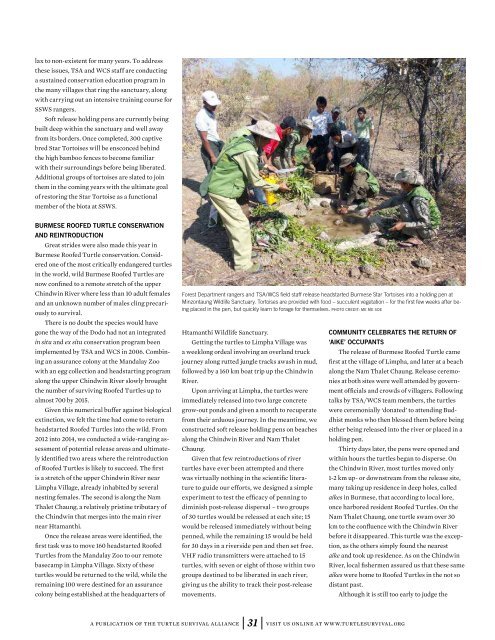Turtle Survival
2tUaeTbNi
2tUaeTbNi
You also want an ePaper? Increase the reach of your titles
YUMPU automatically turns print PDFs into web optimized ePapers that Google loves.
lax to non-existent for many years. To address<br />
these issues, TSA and WCS staff are conducting<br />
a sustained conservation education program in<br />
the many villages that ring the sanctuary, along<br />
with carrying out an intensive training course for<br />
SSWS rangers.<br />
Soft release holding pens are currently being<br />
built deep within the sanctuary and well away<br />
from its borders. Once completed, 300 captive<br />
bred Star Tortoises will be ensconced behind<br />
the high bamboo fences to become familiar<br />
with their surroundings before being liberated.<br />
Additional groups of tortoises are slated to join<br />
them in the coming years with the ultimate goal<br />
of restoring the Star Tortoise as a functional<br />
member of the biota at SSWS.<br />
BURMESE ROOFED TURTLE CONSERVATION<br />
AND REINTRODUCTION<br />
Great strides were also made this year in<br />
Burmese Roofed <strong>Turtle</strong> conservation. Considered<br />
one of the most critically endangered turtles<br />
in the world, wild Burmese Roofed <strong>Turtle</strong>s are<br />
now confined to a remote stretch of the upper<br />
Chindwin River where less than 10 adult females<br />
and an unknown number of males cling precariously<br />
to survival.<br />
There is no doubt the species would have<br />
gone the way of the Dodo had not an integrated<br />
in situ and ex situ conservation program been<br />
implemented by TSA and WCS in 2006. Combining<br />
an assurance colony at the Mandalay Zoo<br />
with an egg collection and headstarting program<br />
along the upper Chindwin River slowly brought<br />
the number of surviving Roofed <strong>Turtle</strong>s up to<br />
almost 700 by 2015.<br />
Given this numerical buffer against biological<br />
extinction, we felt the time had come to return<br />
headstarted Roofed <strong>Turtle</strong>s into the wild. From<br />
2012 into 2014, we conducted a wide-ranging assessment<br />
of potential release areas and ultimately<br />
identified two areas where the reintroduction<br />
of Roofed <strong>Turtle</strong>s is likely to succeed. The first<br />
is a stretch of the upper Chindwin River near<br />
Limpha Village, already inhabited by several<br />
nesting females. The second is along the Nam<br />
Thalet Chaung, a relatively pristine tributary of<br />
the Chindwin that merges into the main river<br />
near Htamanthi.<br />
Once the release areas were identified, the<br />
first task was to move 160 headstarted Roofed<br />
<strong>Turtle</strong>s from the Mandalay Zoo to our remote<br />
basecamp in Limpha Village. Sixty of these<br />
turtles would be returned to the wild, while the<br />
remaining 100 were destined for an assurance<br />
colony being established at the headquarters of<br />
Forest Department rangers and TSA/WCS field staff release headstarted Burmese Star Tortoises into a holding pen at<br />
Minzontaung Wildlife Sanctuary. Tortoises are provided with food – succulent vegetation – for the first few weeks after being<br />
placed in the pen, but quickly learn to forage for themselves. PHOTO CREDIT: ME ME SOE<br />
Htamanthi Wildlife Sanctuary.<br />
Getting the turtles to Limpha Village was<br />
a weeklong ordeal involving an overland truck<br />
journey along rutted jungle tracks awash in mud,<br />
followed by a 160 km boat trip up the Chindwin<br />
River.<br />
Upon arriving at Limpha, the turtles were<br />
immediately released into two large concrete<br />
grow-out ponds and given a month to recuperate<br />
from their arduous journey. In the meantime, we<br />
constructed soft release holding pens on beaches<br />
along the Chindwin River and Nam Thalet<br />
Chaung.<br />
Given that few reintroductions of river<br />
turtles have ever been attempted and there<br />
was virtually nothing in the scientific literature<br />
to guide our efforts, we designed a simple<br />
experiment to test the efficacy of penning to<br />
diminish post-release dispersal – two groups<br />
of 30 turtles would be released at each site; 15<br />
would be released immediately without being<br />
penned, while the remaining 15 would be held<br />
for 30 days in a riverside pen and then set free.<br />
VHF radio transmitters were attached to 15<br />
turtles, with seven or eight of those within two<br />
groups destined to be liberated in each river,<br />
giving us the ability to track their post-release<br />
movements.<br />
COMMUNITY CELEBRATES THE RETURN OF<br />
‘AIKE’ OCCUPANTS<br />
The release of Burmese Roofed <strong>Turtle</strong> came<br />
first at the village of Limpha, and later at a beach<br />
along the Nam Thalet Chaung. Release ceremonies<br />
at both sites were well attended by government<br />
officials and crowds of villagers. Following<br />
talks by TSA/WCS team members, the turtles<br />
were ceremonially ‘donated’ to attending Buddhist<br />
monks who then blessed them before being<br />
either being released into the river or placed in a<br />
holding pen.<br />
Thirty days later, the pens were opened and<br />
within hours the turtles began to disperse. On<br />
the Chindwin River, most turtles moved only<br />
1-2 km up- or downstream from the release site,<br />
many taking up residence in deep holes, called<br />
aikes in Burmese, that according to local lore,<br />
once harbored resident Roofed <strong>Turtle</strong>s. On the<br />
Nam Thalet Chaung, one turtle swam over 30<br />
km to the confluence with the Chindwin River<br />
before it disappeared. This turtle was the exception,<br />
as the others simply found the nearest<br />
aike and took up residence. As on the Chindwin<br />
River, local fishermen assured us that these same<br />
aikes were home to Roofed <strong>Turtle</strong>s in the not so<br />
distant past.<br />
Although it is still too early to judge the<br />
a publication of the turtle survival alliance 31 visit us online at www.turtlesurvival.org


